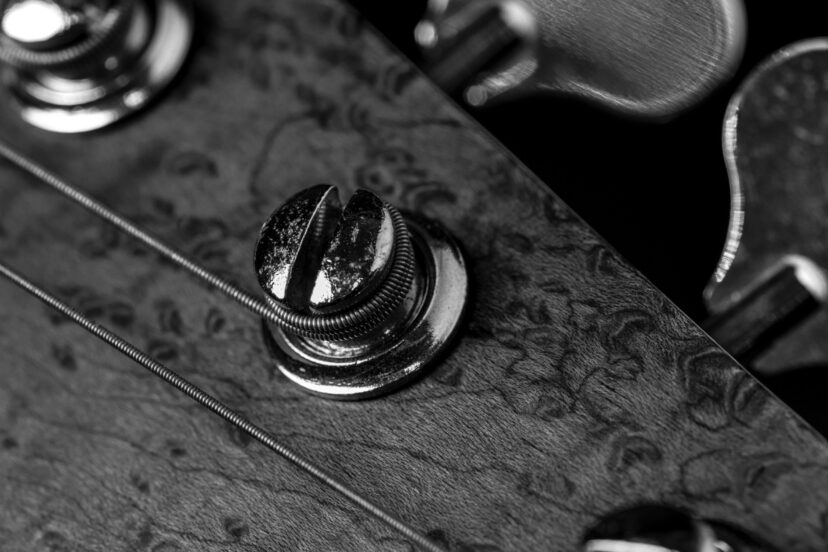Bass Guitar Parts: Your Comprehensive Guide
Introduction: Understanding Your Bass Guitar
Lets explore what comprises the parts that make up your bass guitar. As players, we owe it to ourselves and our beloved instruments to understand them as best as we can. It helps with maintaining your axe and keeping it sounding it’s best.
The Importance of Knowing Your Instrument
Understanding the various parts of your bass guitar allows you to communicate effectively with other musicians and technicians, troubleshoot any issues that may arise, and ensure that your instrument stays in top shape.
Anatomy of a Bass Guitar: Breaking it Down
From head to toe—or rather, from headstock to bottom strap button—here’s what makes up your bass guitar:
Headstock
This is the topmost part of the bass guitar where you’ll find the tuning machines. Brands often display their logos here. The headstock, or the “head” of the bass, is where you’ll find the tuning pegs. These pegs, or tuners, are crucial for tuning your strings to the right pitch. You’ll encounter various types, from vintage-style open-gear tuners to modern sealed designs. Each has its charm, but the key is stability and accuracy in tuning.
Fingerboard
Closely related to the neck is the fingerboard, or fretboard, which houses the frets. Traditionally made from maple or rosewood, newer materials like ebony or even synthetic composites are also popular. The material choice impacts the bass’s tone, with harder woods providing a brighter, more defined sound.
Nut
A small but crucial part, the nut elevates the strings off the fingerboard and helps guide them to the tuning machines. They can be made out of various materials and those materials provide different sound characteristics.
Materials Used for a Bass Guitar Nut
1. Bone:
- Description: Traditional material known for its density and hardness. Provides a bright, clear tone.
- Pros: Excellent tonal quality, durability.
- Cons: Requires more maintenance, can be expensive.
2. Plastic:
- Description: Commonly used material, available in various types such as ABS, Delrin, and other synthetic polymers.
- Pros: Affordable, easy to work with, and widely available.
- Cons: May wear out faster, can have a duller tone compared to bone.
3. Graphite:
- Description: Composite material combining graphite and other resins.
- Pros: Self-lubricating (reduces string friction), durable, provides a balanced tone.
- Cons: Can be more expensive than plastic, less traditional.
4. Tusq:
- Description: Synthetic material designed to mimic the tonal properties of bone.
- Pros: Consistent quality, good tonal properties, and no animal products.
- Cons: More expensive than standard plastic.
5. Brass:
- Description: Metal nut, less common but used for specific tonal characteristics.
- Pros: Very durable, bright tone.
- Cons: Can be heavy, difficult to install and shape, may require more maintenance to avoid corrosion.
6. Corian:
- Description: Another synthetic material similar to Tusq.
- Pros: Durable, good tonal quality, available in various colors.
- Cons: May not be as readily available as other materials.
Purpose and Role of the Nut on a Bass Guitar
1. String Spacing:
- Role: The nut ensures that the strings are evenly spaced and held in the correct positions over the fretboard. This spacing is crucial for playability and ensures that each string aligns properly with the neck and bridge.
2. String Height:
- Role: The nut contributes to the overall string height or action of the bass guitar. Proper nut height allows for comfortable playability and prevents fret buzz. It is one of the factors in setting up the instrument’s action.
3. Tone and Sustain:
- Role: The material of the nut can influence the tonal characteristics of the bass guitar. Different materials can affect the brightness, warmth, and sustain of the notes. For example, bone nuts are known for their clear and bright tone, while plastic nuts might produce a slightly mellower sound.
4. Stability and Tuning:
- Role: A well-made nut ensures that the strings remain stable and return to pitch after bending or tuning. Materials like graphite help reduce friction, allowing the strings to move smoothly and stay in tune better.
5. Transmission of Vibrations:
- Role: The nut transfers the vibrations from the strings to the neck of the bass guitar. This transfer is essential for the overall resonance and tonal quality of the instrument. A high-quality nut material can enhance the resonance and sustain of the bass guitar.
Neck
The long piece that stretches from the headstock to the body. It houses the fretboard where you press down to create different notes. The neck of your bass is your main playground. It’s where your fingers dance across the frets to create those sweet or funky tones. Necks come in different profiles and constructions—bolt-on, set-neck, and neck-through, each offering distinct sustain and access to higher frets. The choice here affects both the sound and how the bass feels in your hands.
Frets
These metal strips divide the fingerboard into semitone intervals. They’re what make the bass a fretted instrument, allowing for precise note playing. The debate between fretted and fretless is a tale as old as time, with the choice boiling down to the sound and style you’re after.
Materials Used for Frets on a Bass Guitar
1. Nickel Silver (Nickel-Silver Alloy):
- Description: The most common material used for frets, also known as German Silver. Despite the name, it contains no actual silver, typically made from 18% nickel, 80% copper, and 2% other metals.
- Pros: Durable, relatively easy to work with, produces a balanced tone.
- Cons: Can wear down over time with heavy use.
2. Stainless Steel:
- Description: A harder, more durable alternative to nickel silver.
- Pros: Extremely durable, resistant to wear and corrosion, produces a bright tone.
- Cons: Harder to work with and more difficult to install, can cause more wear on strings.
3. Gold Alloy:
- Description: A high-end fret material that includes gold, often mixed with nickel and other metals.
- Pros: Corrosion-resistant, aesthetically pleasing, produces a warm tone.
- Cons: Expensive, not as widely available, and can be softer than stainless steel.
4. EVO Gold:
- Description: A copper alloy with a distinctive gold color, not containing actual gold.
- Pros: Durable, resistant to wear and corrosion, visually appealing.
- Cons: More expensive than nickel silver, harder to find.
Purpose and Role of the Frets on a Bass Guitar
1. Defining Pitch:
- Role: Frets divide the neck of the bass guitar into fixed intervals, each representing a semitone. Pressing a string down behind a fret shortens the vibrating length of the string, raising its pitch to a specific note. This allows players to produce accurate and consistent pitches.
2. Facilitating Playability:
- Role: Frets provide a physical guide for finger placement, making it easier for players to find and play notes accurately. This is especially important for beginners, as it helps in developing muscle memory and precision.
3. Enhancing Sustain:
- Role: The contact between the string and the fret helps to maintain the vibration of the string, contributing to the sustain of the note. The material and condition of the frets can affect the length and quality of the sustain.
4. Tone Production:
- Role: The material and condition of the frets can influence the tonal characteristics of the bass guitar. For example, stainless steel frets tend to produce a brighter tone, while nickel silver frets might offer a more balanced sound. Worn or poorly maintained frets can negatively impact tone and intonation.
5. Intonation and Tuning Stability:
- Role: Properly installed and maintained frets ensure that the bass guitar has accurate intonation, meaning that each note is in tune along the entire neck. This is crucial for playing in tune, especially in higher registers. Uneven or worn frets can cause intonation issues and buzzing, affecting the overall playability and sound.
6. Durability and Maintenance:
- Role: The durability of the fret material affects how often a bass guitar will need maintenance or refretting. Harder materials like stainless steel last longer and require less frequent maintenance, whereas softer materials may need more frequent attention to keep the instrument in optimal playing condition.
Body
The large part of the instrument to which the neck is attached. It houses the pickups, bridge, and control knobs. The body isn’t just the part that rests against yours when playing; it’s the heart of the bass’s tone and resonance. From solid to semi-hollow, the shape and material of the body (be it alder, ash, or mahogany) play a significant role in shaping your sound. Plus, it’s where most of the hardware and electronics are mounted.
Pickups
Ah, pickups—the microphones of your bass. They capture the vibrations of the strings and convert them into an electrical signal. The choice between single-coil and humbucker pickups affects your bass’s noise level and tone. Single-coils are bright and punchy, while humbuckers offer a warmer, fuller sound.
Bridge
The bridge anchors the strings to the body, playing a pivotal role in sustain and intonation. Whether it’s a traditional four-saddle design or a more modern high-mass bridge, its construction and material significantly influence the overall sound and feel of your bass.
Control Knobs
Volume and tone controls, along with pickup selectors, are your main interface for shaping your sound on the fly. Learning how to use these effectively can drastically change your tone, from deep, rumbling lows to sparkling highs.
Electronics
Electronics can seem daunting, but they’re essential for shaping your sound. Active electronics offer more tonal control and higher output, perfect for modern playing styles. In contrast, passive electronics provide a classic tone beloved in vintage basses. Understanding this can help you tailor your sound to your exact needs.

Importance of Each Part in Sound Production
Every part of a bass plays a role in sound production. The body, neck, and bridge contribute to the guitar’s resonance. The pickups, control knobs, and frets are directly responsible for the sound you hear when you play.
Basic Maintenance and Care for Your Bass Guitar
Now, let’s talk about some essential care tips to ensure that all these parts function properly for years to come:
Cleaning Your Bass: Regular cleaning is essential. Wipe down your guitar after every use to prevent dirt and sweat from accumulating.
Changing the Strings: Over time, strings lose their brightness and become dull in tone. Changing your strings regularly will help maintain the sound quality of your bass and keep it better tuned.
Regular Checkups: Just like us humans need regular health checkups, so do our bass guitars. It’s beneficial to have your instrument inspected by a professional once in a while to ensure everything is working as it should.

Conclusion: Embracing the Complex Simplicity of Your Bass
So, there we have it! We’ve journeyed through the various parts that make up your beloved bass guitar. Each part, no matter how small, plays a crucial role in creating the sound we all love. It’s truly a marvel of design and engineering, isn’t it? Remember to keep your bass guitar clean and well-maintained, and it’ll continue to produce amazing sounds for years to come.
FAQ’s
- What are the most important parts of a bass guitar to upgrade?
Upgrading the pickups or bridge can significantly improve your bass’s sound and playability. These are great starting points for customization. - Can I replace bass guitar parts myself?
Many parts, like pickups and tuners, can be replaced with basic tools and some research. However, for more complex tasks, consulting a professional might be best. - How do different body materials affect the sound?
Heavier woods like mahogany offer a warmer, richer tone, while lighter woods like alder and ash provide a brighter sound with more pronounced highs. - What’s the difference between active and passive basses?
Active basses have a built-in preamp for extra tone shaping and higher output, while passive basses rely on the natural sound of the pickups, offering a more traditional tone. - How do I know when to maintain or replace parts of my bass guitar?
Regular play and sound checks will alert you to any changes in performance. If your bass starts sounding dull or the hardware becomes unreliable, it’s time for maintenance or an upgrade.




